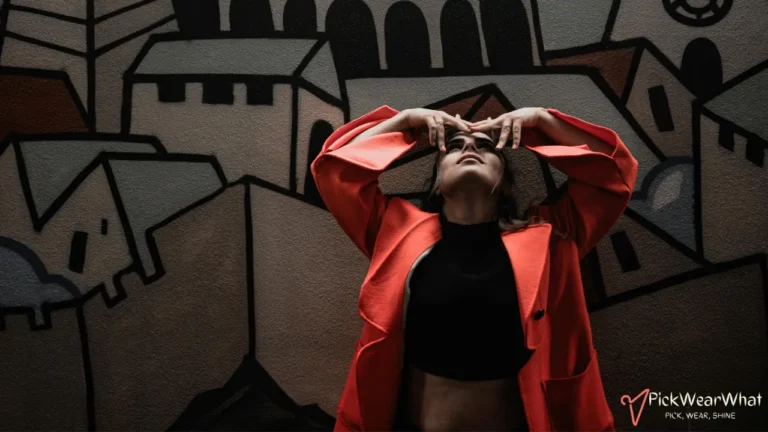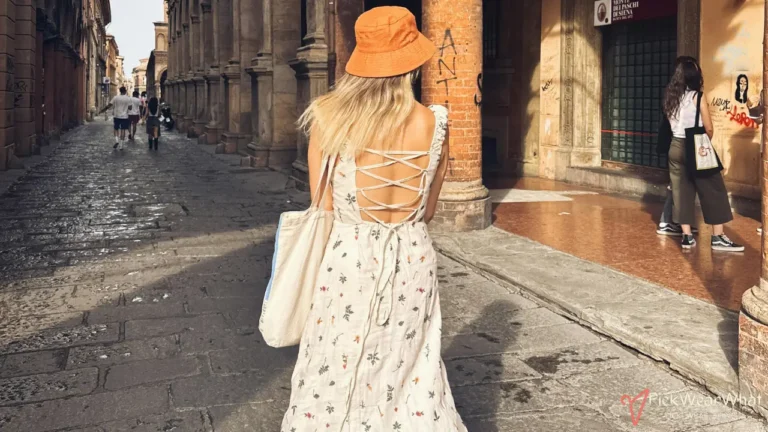Rome has a Mediterranean climate with hot summers and mild winters. In spring (March-May) and autumn (September-November), light layers like jackets and sweaters are suitable.
Summers (June-August) are hot and dry; wear lightweight, breathable clothes and sunscreen. Winters (December-February) are cool and can be rainy; a warm jacket and an umbrella are recommended.
On my spring trip to Rome, comfortable walking shoes were essential for exploring historic sites. A light jacket was handy for cooler evenings, and dressing modestly allowed me to visit all attractions without issues.
What To Wear in Rome by Month from Jan to Dec?
Rome’s weather follows a classic Mediterranean rhythm: mild, damp winters; warm, blossoming springs; hot, sun-saturated summers; and pleasantly crisp autumns. While historic averages rarely plunge below freezing or soar far past the mid-thirties Celsius, climate change has made heat waves and heavy downpours more common in recent years.
Planning month-by-month therefore means pairing long-term climate data with a readiness for the occasional weather anomaly, whether that’s a chilly tram ride in March or an unusually tropical burst of rain in August.
| Month | Avg High °C / °F | Avg Low °C / °F | Men: Core Items | Women: Core Items |
|---|---|---|---|---|
| January | 12 / 54 | 3 / 37 | Mid-weight wool coat, merino sweater, dark jeans, leather boots, scarf, compact umbrella | Wool-blend coat, knit dress with tights, ankle boots, pashmina, umbrella |
| February | 13 / 56 | 4 / 38 | Quilted jacket, flannel shirt, chinos, waterproof sneakers | Longline cardigan, thermal top, midi skirt with leggings, waterproof boots |
| March | 16 / 60 | 6 / 42 | Light parka, cotton sweater, chinos, loafers | Trench coat, long-sleeve blouse, culottes, loafers |
| April | 19 / 66 | 9 / 47 | Unlined blazer, breathable polo, lightweight trousers, suede sneakers | Cropped trench, linen shirt-dress, ballet flats |
| May | 23 / 74 | 13 / 54 | Linen-blend blazer, short-sleeve shirt, chino shorts, boat shoes | Denim jacket, sleeveless top, midi skirt, espadrilles |
| June | 27 / 81 | 16 / 60 | Seersucker shirt, tailored shorts, breathable loafers, sun hat | Cotton sundress, light shawl, strappy sandals, wide-brim hat |
| July | 30 / 87 | 19 / 65 | Moisture-wicking tee, performance shorts, leather sandals, packable cap | Sleeveless linen dress, airy kimono, gladiator sandals |
| August | 30 / 87 | 19 / 65 | Open-collar shirt, chino shorts, UV-blocking sunglasses | Flowy sleeveless jumpsuit, sandals, sun hat, sunglasses |
| September | 26 / 80 | 16 / 60 | Lightweight knit, roll-up chinos, canvas sneakers | Jersey wrap dress, light cardigan, sneakers |
| October | 22 / 72 | 12 / 53 | Cotton blazer, long-sleeve tee, dark jeans, desert boots | Trench, long-sleeve blouse, pleated skirt, ankle boots |
| November | 17 / 62 | 8 / 45 | Wool bomber, henley shirt, heavier chinos, waterproof shoes | Wool coatigan, knit sweater, jeans, waterproof ankle boots |
| December | 13 / 55 | 4 / 39 | Peacoat, cashmere scarf, thermal undershirt, leather boots | Belted wool coat, knit dress with tights, knee-high boots |
January Wardrobe Tips For The Eternal City
January is Rome’s coldest month, though snow remains rare. Expect chilly mornings around 3 °C and afternoon highs near 12 °C. Waterproof outerwear is essential because winter drizzle can appear without warning.
Layer a thermal base, mid-weight sweater, and wool coat; swap boots for Chuck-style sneakers only on dry cobblestone days. Locals keep colours muted—charcoal, navy, and oxblood—so bright ski jackets instantly signal “tourist.”
February Layering Strategies In The Roman Chill
The mercury creeps up only slightly in February, but carnival celebrations bring bursts of outdoor activity. Opt for a quilted jacket over a flannel shirt and chinos. Women often pair thermal leggings with midi skirts for café-to-cathedral versatility. Scarves add both warmth and a dash of Italian flair—look for soft checks or subtle herringbone rather than oversized branding.
March: Transitioning From Winter To Primavera
March feels unpredictable: a warm, sunny lunch on a terrace can turn into a damp, gusty evening. A light parka or water-resistant trench plus a cotton sweater provides just-right flexibility. Consider packing leather loafers for drier days; rubber-soled shoes grip wet basalt better than smooth dress soles.
April’s Blossoms And Sudden Showers
Rome’s legendary wisteria climbs across alleyways by mid-April, but spring showers are equally famous. A cropped trench or waxed-cotton jacket wards off sprinkles without overheating. Neutral layers—think oatmeal cardigans and sand-coloured chinos—blend naturally with Rome’s warm-stone architecture.
May Means Longer Days And Lighter Fabrics
With daylight stretching past 8 p.m. and highs nudging the mid-twenties, swap merino for linen. Men can keep things polished with a linen-blend blazer and tailored shorts; women often choose an A-line skirt that catches late-spring breezes. Evenings can still cool quickly, so keep a lightweight scarf in your daypack.
June: Early Summer Heat Arrives
By mid-June, the hot season starts in earnest. Perspiration-wicking fabrics—Tencel tees, seersucker shirts—are lifesavers on crowded Metro rides. A sun hat is as important as a reusable water bottle, especially when touring the Forum’s shade-free marble.
July’s Sun-Soaked Siestas
July averages hover around 30 °C, and record highs in recent years have breached 40 °C during heatwaves. Loose silhouettes, open-weave fabrics, and breathable footwear define locals’ summer wardrobes. Churches still require covered shoulders, so pack a lightweight shawl that folds into your tote.
August: Ferragosto And Peak Temperatures
Many Romans leave the capital in August, but key sights remain busy. Expect intense UV between 11 a.m. and 4 p.m. A sleeveless jumpsuit or open-collar shirt, paired with SPF 50 and dark sunglasses, keeps you comfortable without sacrificing modesty. Plan museum visits for the hottest hours.
September’s Gentle Cool-Down
September blends summer warmth with crisper evenings. A soft‐knit pullover paired with roll-up chinos suits men well, while women often alternate between wrap dresses and denim jackets. Thin socks help prevent sandal blisters during transitional footwear weeks.
October: Golden Light And Light Layers
Highs in the low twenties create perfect walking weather. The classic trench reigns supreme, accompanied by long-sleeve tees, dark jeans, and leather ankle boots. Earth-toned accessories—burnt sienna bags, moss green scarves—mirror the fading vineyard leaves of nearby Lazio hills.
November’s Rain-Tipped Breezes
November marks the heart of Rome’s rainy season. Downpours can flood narrow lanes, so waterproof shoes matter more than ever.
A wool bomber or coatigan layered over a lightweight sweater handles day-long museum visits and brisk Tiber strolls alike. Keep a folding umbrella handy; locals dislike oversized golf umbrellas blocking portico space.
December: Festive Vibes And Cozy Textures
From Christmas markets in Piazza Navona to midnight masses, December calls for warmth and a touch of elegance. Men’s peacoats and women’s belted wool coats photograph beautifully against twinkling lights. Thermal undershirts keep weight down; cashmere scarves add quiet luxury without bulk.
What To Wear in Rome by Season?
Thinking in seasons simplifies packing because it groups months by temperature mood. Summer in Rome feels categorically hot and dry; winter is chilly and damp; spring and autumn each balance warmth, cool evenings, and the chance of sudden showers.
Understanding these broad patterns helps you choose versatile fabrics and footwear, ensuring one suitcase covers sightseeing, dining out, and the odd religious service without overstuffing your luggage.
| Season | Temp Range °C | Key Weather Traits | Men: Go-To Pieces | Women: Go-To Pieces |
|---|---|---|---|---|
| Spring (Mar–May) | 16–24 | Mild, possible showers, longer daylight | Light trench, cotton sweater, chinos, loafers | Denim jacket, linen dress, culottes, ballet flats |
| Summer (Jun–Aug) | 27–35+ | Hot, dry, high UV, occasional heatwave | Seersucker shirts, tailored shorts, breathable loafers, straw hat | Linen sundress, kimono layer, gladiator sandals, sun hat |
| Autumn (Sep–Nov) | 17–27 | Warm days, crisp nights, increased rain in Nov | Unlined blazer, mid-weight knit, dark jeans, desert boots | Trench coat, wrap dress, ankle boots |
| Winter (Dec–Feb) | 8–14 | Cool, damp mornings, drizzle, short daylight | Wool coat, scarf, thermal layer, leather boots | Belted wool coat, knit dress, thermal tights, waterproof boots |
Staying Cool And Stylish In Summer
Rome’s compact centre radiates heat absorbed by stone facades; thermometer readings may not reflect how sweltering the streets actually feel at midday. Breathable natural fibres—linen, cotton, Tencel—help perspiration evaporate, while open-weave straw hats provide shade without trapping heat. Choose sandals with proper arch support; cobblestones punish flimsy flip-flops.
Men often replace belts with side-tab tailored shorts to minimise constriction, and women commonly carry a gauzy shawl for church visits. Always fill a reusable bottle at one of the city’s 2,500 free nasoni water fountains.
Navigating The Mild Charms Of Spring
From citrus blossoms in March to full-leaf plane trees by May, spring invites leisurely outdoor lunches and evening passeggiatas along the Tiber. Temperature swings between early morning and late afternoon warrant clever layering: a cotton sweater over a breathable base and a trench that fits into a tote by noon.
Opt for shoes that handle occasional rain—waxed leather loafers, treated canvas sneakers—while still pairing well with trattoria smart-casual dress codes.
Dressing Smart When Autumn Leaves Fall
Autumn rewards travellers with golden light and thinner crowds. September can feel summery, but by November, Rome logs its heaviest rainfall of the year. Choose quick-drying fabrics and carry a compact travel umbrella.
Earthy palettes—rust, olive, camel—mesh beautifully with chestnut-leaf strewn streets and ochre ruins. A waterproof desert boot or Chelsea boot bridges day tours and evening aperitivo experiences, sparing you the need for multiple shoe changes.
Keeping Warm And Fashionable In Winter
Damp chill, not snow, defines Roman winters. Average highs sit in the low teens, but penetrating humidity can make conditions feel colder, especially after sunset. A wool coat layered over a heat-retaining base—merino or synthetic—is key.
Accessories pull double duty: a cashmere beanie keeps ears warm and elevates photos; leather gloves protect fingers from scooter handles and smartphone snaps alike. Choose footwear with non-slip soles; tiled church floors and marble steps become slick during drizzle.
Essential Fabrics And Layers For Italian Comfort
Choosing the right material is half the battle against Roman weather extremes. Natural fibres such as linen and cotton dominate summer wardrobes because they breathe and drape elegantly. For shoulder seasons, blend fabrics—cotton-cashmere, wool-silk—that insulate without bulk.
In winter, merino wool provides warmth even when damp, while modern synthetics like PrimaLoft offer lightweight insulation for minimalists. Layer order matters: moisture-wicking base, insulating mid-layer, weather-proof shell. This system lets you shed or add pieces as you move from sun-kissed piazzas to cool, echoing basilicas.
Footwear Advice For Rome’s Cobblestone Streets
Footwear makes or breaks a Roman holiday. Cobblestones (sampietrini) are beautiful but uneven; they devour thin soles and punish high heels. Look for rubber or crepe outsoles with tread. Men’s go-tos include leather sneakers or desert boots, while women favour block-heel ankle boots or cushioned loafers.
In summer, leather sandals with arch support are acceptable, but flimsy flip-flops signal tourist and leave feet dusty. When visiting religious sites, covered toes are best; pack foldable ballet flats if sandals are your day choice.
Accessory Choices That Blend Style And Function
A stylish scarf is every Roman’s secret weapon—warm in winter, sun-shield in summer, and always a quick way to seem put-together. Choose neutral patterns for maximum versatility.
Sunglasses with UV400 lenses protect against Mediterranean glare. A structured crossbody bag deters pickpockets while freeing hands for gelato and photo ops. If you carry a backpack, opt for slim profiles—oversized hiking packs draw unwanted attention and bump fellow bus passengers.
Cultural Etiquette And Dress Codes Explained
Romans dress with understated elegance. Inside churches—including St. Peter’s Basilica and the Pantheon—shoulders and knees must be covered for all genders. Men can meet the rule with a light button-down and long shorts or trousers, while women often drape a scarf over sleeveless tops or choose midi lengths.
At fine-dining trattorias, smart casual reigns: crisp shirts, dark jeans, leather shoes, or a simple dress with low heels. Large sports logos, beachwear, and athleisure look out of place in most evening settings.
Packing Checklist For Weekend, Weeklong, And Extended Stays
Packing light yet complete means thinking in interchangeable “modules.” For a weekend, two tops, one bottom, and one outer layer suffice when all colours coordinate. A weeklong trip expands to five tops, two bottoms, one dress or blazer, and two pairs of shoes.
Travellers staying a fortnight or more should plan to do laundry—self-service laundromats or hotel services are widespread—allowing rotation of seven tops, three bottoms, and mixed-weight layers instead of overstuffing suitcases. Compression cubes keep items organised and shrink volumes in carry-ons.
Frequently Asked Questions About Dressing In Rome
Rome’s dress code puzzles many visitors, so the following answers clarify common concerns while reinforcing etiquette and comfort guidelines.
Can I Wear Jeans To The Vatican Museums?
Yes, jeans are acceptable provided they’re free of rips and paired with a top that covers shoulders. Religious sites focus on modesty over formality, so dark, well-fitting denim combined with a collared shirt or a sleeve-covering blouse meets expectations without looking overly casual. Add a lightweight scarf to bridge any borderline-sleeve doubts.
Do Romans Wear Shorts?
Locals do wear shorts, particularly younger Romans and anyone heading to parks or the seaside, but styles skew tailored and knee-length. Cargo shorts and athletic gym styles mark tourists instantly. Opt for slim chino or linen shorts paired with loafers or clean sneakers to blend in and stay cool.
What Shoes Work Best On Cobblestones?
Rubber-soled leather sneakers, low block-heel boots, and cushioned loafers strike the balance between style and practicality. They absorb impact, grip uneven stones, and transition gracefully to dinner settings. Avoid stilettos and thin sandals, which catch between stones and lead to quick foot fatigue.
Is Rain Gear Necessary All Year?
A compact umbrella belongs in every season’s day bag. While summer rain is scarce, spring and autumn showers arrive suddenly, and winter drizzle can last hours. Pack a lightweight waterproof layer—think fold-away shell or waxed-cotton jacket—rather than a heavy raincoat if visiting outside the wettest weeks of November.
How Do I Dress Up For A Night Out Without Overpacking?
Versatility is key: a dark, wrinkle-resistant dress for women or an unstructured navy blazer for men elevates any outfit. Pair with leather shoes you already plan to wear sightseeing, add a statement accessory (silk scarf or pocket square), and you’re cocktail-ready without extra luggage weight.




